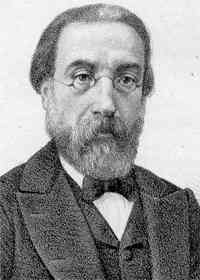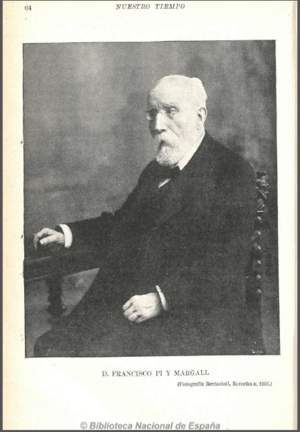Francesc Pi i Margall facts for kids
Quick facts for kids
Francesc Pi i Margall
|
|
|---|---|
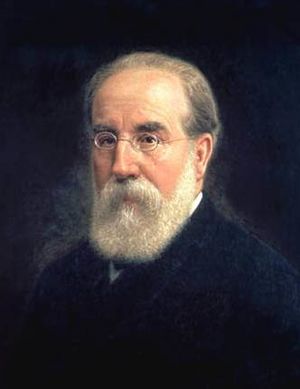
Portrait by José Sánchez Pescador
|
|
| President of the Executive Power | |
| In office 11 June 1873 – 18 July 1873 |
|
| Preceded by | Estanislao Figueras |
| Succeeded by | Nicolás Salmerón |
| Personal details | |
| Born | 29 April 1824 Barcelona, Spain |
| Died | 29 November 1901 (aged 77) Madrid, Spain |
| Political party | Democratic Federal Democratic Republican |
| Spouse | Petra Arsuaga |
| Children | 3, including Francisco and Joaquín |
| Parents |
|
| Signature | |
Francesc Pi i Margall (Spanish: Francisco Pi y Margall) (born April 29, 1824 – died November 29, 1901) was an important Spanish politician and thinker. He believed in a system called federalism, where different regions have more power. He was also a republican, meaning he thought Spain should have a republic (a country led by elected officials) instead of a king.
Pi i Margall briefly served as president of the First Spanish Republic in 1873. He was also a historian, philosopher, and writer. He led the Federal Democratic Republican Party and the Democratic Party. His ideas greatly influenced the development of the anarchist movement in Spain.
Contents
Early Life and Education
Francesc Pi i Margall was born in Barcelona, Catalonia, on April 29, 1824. His father worked in a textile factory. In 1831, his father sent him to a religious school where he learned about history, literature, and ancient languages.
He joined a group called the Societat Filomàtica. This allowed him to meet many important writers and thinkers of the Catalan Romantic movement. In 1837, he began studying law and earned his degree in 1847. That same year, he moved to Madrid. There, he started writing as a theater critic for newspapers and published his first political article.
Political Beginnings
Pi i Margall became involved in the revolution of 1854. This event brought a liberal leader named Baldomero Espartero back into power. In 1854, Pi i Margall published a book called La reacción y la revolución (Reaction and Revolution). This book showed his ideas about history and politics.
In 1856, he started a new newspaper called La Razón (The Reason). However, the government closed it down. Pi i Margall had to leave Madrid for a short time. He returned in 1857 to write for another Republican newspaper, La Discusión. Here, he met many leaders of the Spanish republican movement, including Estanislao Figueras, who would also become president later. By 1864, Pi i Margall became the director of La Discusión.
After a military uprising in 1866, Pi i Margall went to Paris. In Paris, he gave lectures and translated books by a French thinker named Pierre-Joseph Proudhon. He developed his ideas about history and how societies change. He believed that history naturally moves towards more freedom, often through federal systems. He always promoted the idea of a republic with a federal structure.
Return to Politics and the Republic
Pi i Margall came back to Spain after the Glorious Revolution in 1868. This revolution ended the monarchy. He was elected as a representative for Barcelona. He helped write the new 1869 Constitution. During this time, he became a respected leader of the Republican party. In March 1870, he was officially named the head of the party.
He strongly believed that Spain should become a federal republic instead of a monarchy. He opposed the rule of King Amadeo I.
Presidency of Spain
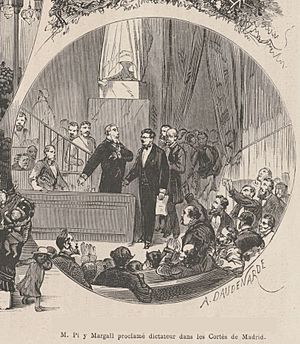
When King Amadeo I gave up his throne, the First Spanish Republic was formed in 1873. The first president, Estanislao Figueras, made Pi i Margall the Minister of the Interior. In this role, Pi i Margall had to deal with a movement called the cantonalist movement in different parts of Spain. These groups wanted even more local power.
When President Figueras resigned on June 11, 1873, Pi i Margall became the new president. He had big plans for Spain. These included:
- Making the separation between church and state stronger.
- Reorganizing the army.
- Reducing the working day to eight hours.
- Creating rules for child labor.
- Improving relationships between businesses and workers.
- Giving more power to Spain's regions.
- Starting a program for universal education.
Pi i Margall was able to work well with both Republicans and socialists. However, he struggled to control the instability of the new Republic. On July 1, some more extreme Republicans and federalists declared his government illegitimate. New uprisings happened in places like Alcoy and Cartagena just a week later.
Under pressure from other politicians, Pi i Margall resigned on July 18, 1873. He had been president for only a little over a month.
Later Political Life and Writings
After the Republic ended in 1874, Pi i Margall stepped away from politics for ten years. During this time, he focused on his writing. A few months after the Republic fell, he wrote a book about its events called La República de 1873. He also wrote Las Nacionalidades (Nationalities) and Joyas Literarias (Literary Jewels) in 1876.
He published the first part of his Historia General de América (General History of America) in 1878. Other works included La Federación (The Federation) in 1880, and Las luchas de nuestros días (The Struggles of Our Days) in 1884.
In 1886, he returned to politics. He was elected as a representative for Figueres, in Catalonia, and again in 1891 and 1893. He worked to unite the different parts of the Spanish Republican movement. In 1894, he helped create a new plan for the Federal Party. In 1890, Pi i Margall started a newspaper called El Nuevo Régimen (The New Regime), which supported Cuba's independence. His ideas about federalism and regional power made him popular among many people in Catalonia.
Francesc Pi i Margall died on November 29, 1901, in Madrid.
His Ideas and Influence
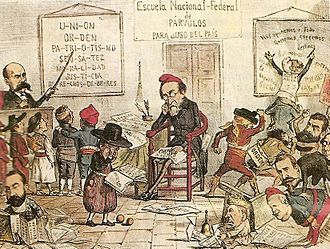
Pi i Margall was the main person who translated the works of Proudhon into Spanish. These translations had a big impact on the development of anarchism in Spain after 1870. Before that, Proudhon's ideas, as explained by Pi i Margall, inspired the federalist movement that grew in the 1860s.
Pi i Margall saw federalism as "unity in variety." He believed it was a natural way to organize society, based on agreements between "natural and spontaneous collective beings."
He was also an important thinker himself. His books like La reacción y la revolución (Reaction and Revolution, 1855), Las nacionalidades (Nationalities, 1877), and La Federación (The Federation, 1880) show his deep ideas. Rudolf Rocker, a famous anarcho-syndicalist, said that Pi i Margall was one of the most important thinkers of his time. He had a strong influence on libertarian ideas in Spain. Pi i Margall wanted to limit the power of the government as much as possible. He hoped to slowly replace it with a socialist economic system.
He also supported the idea of a decentralized Iberian Federalism. This meant he wanted the different "Iberian nations" (like Spain and Portugal) to work together but keep their own unique identities and powers. He thought that a strong central government, along with monarchy, was a main reason for the problems in the Iberian Peninsula.
Pi i Margall had a special admiration for the United States.
Images for kids
See also
 In Spanish: Francisco Pi y Margall para niños
In Spanish: Francisco Pi y Margall para niños


